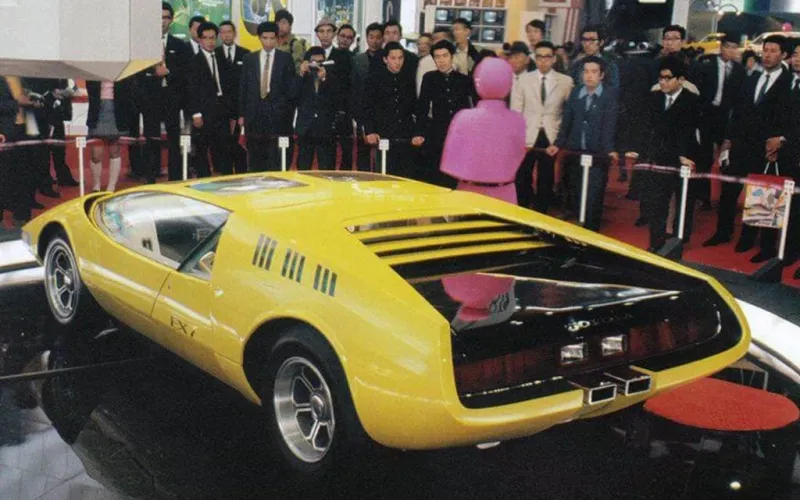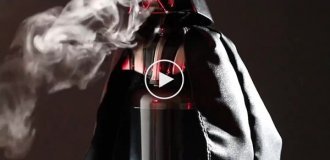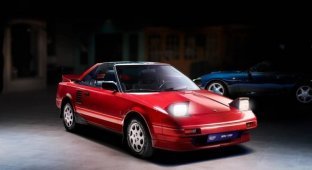Toyota EX-7 concept - a look into the future (10 photos)
One high-performance Toyota model that, to unfortunately, remained only in the form of a single concept, was wonderful model EX-7, presented at the Tokyo Motor Show in 1970 year. This radical supercar was based on a racing car. 
In the late 1960s, in the eyes of a simple layman, Japanese the cars were nothing special. Largely they were simple, fairly cheap, though solid cars. First an attempt to change the existing image was the Toyota 2000GT - sporty car manufactured by Toyota in 1967. It cannot be said that the car was a serious commercial success, but thanks to her about the Japanese companies have spoken. In order to build on the success in the early 1970s, Toyota prepared a number of sports prototypes, the most impressive of which was Toyota EX-7.
Toyota 7 
In 1967, at the initiative of Jiro Kawano, head of the sports division of Toyota, a promising Toyota racing car was developed 7. It was an open rear-wheel drive mid-engined sports prototype with space-frame steel frame, equipped with a 3-liter 300 hp V8 engine The car weighed only 800 kg and due to perfectly tuned chassis and verified aerodynamics, showed great results. In the 1968-1969 season. Toyota 7 wins seven out of ten races in the Japanese Grand Prix Championship.
The machine has constantly evolved and in 1970 reached its the most "combat-ready" state. The car was still space frame, but it was made of aluminum. Other nodes have also been relieved. So the engine block and the gearbox housing was made of magnesium alloy, and the levers the front suspension and driveshaft were made of titanium. As consequently, the car came out incredibly light - only 620 kg! 
The engine looked no less impressive. Especially for new "seven" specialists of Toyota Sports Corner (Tosco) have developed turbocharged 8-cylinder V-engine. It was a short walker DOHC type motor with two 16-valve twin-shaft cylinder heads. The basis of his power were a Nippon Denso mechanical injection power system and two huge Garrett turbochargers. With a working volume of 4986 cm3, the engine Toyota 7 in the maximum boost mode gave out a monstrous 800 hp. and 725 Nm of torque. At that time it was the most powerful car in the world!
With such a machine, Toyota could count on unconditional leadership in its class, but in 1970 the main competitor in the face of Nissan abruptly withdrew from the Grand Prix. In these conditions to continue sponsoring and participating in the national championship was no longer appropriate.
Experimental-7 
The racing career of the Toyota 7 is over, but the excellent chassis remains. AT October 1970, visitors to the 17th Tokyo Motor Show at the booth Toyota has discovered something fundamentally new that has never been seen before. seen. It was a defiant black and yellow sports car with an understated silhouette. (height 1055 mm) in a trendy wedge design.
The prototype called Toyota EX-7 (EX-experimental), became an attempt to imagine what GT cars of the next future. The central feature of the machine was the opening system doors. The roof, massive side windows and doors were combined into a kind of "lid" that opened up, against the course of movement. 
The futuristic theme loudly declared in the exterior was developed and in the interior. As befits Japanese technology, the EX-7 was right-hand drive. AT inside the sports car there were two chairs with a high back and a developed lateral support. Their central armrests were continued on which housed various control buttons and a cassette deck audio systems. To the right of the driver was an intricate cylinder, where controls were included. 
From the point of view of mechanics, the EX-7 differed from the original racing "seven" not too much. In order not to greatly shock the Japanese public, dismantling turbochargers, engine power was reduced to 450 hp. Certainly not it is known what real technical characteristics Toyota had EX-7, but according to rumors, it accelerated from 0 to 100 km / h in no more than 5 seconds, and its maximum speed reached 280 km / h. 
The experimental EX-7 never entered mass production. planned. After the Tokyo Motor Show, the concept built in a single copy traveled around several more exhibitions, and then went to the Toyota Factory Museum, where he remains to this day. 























